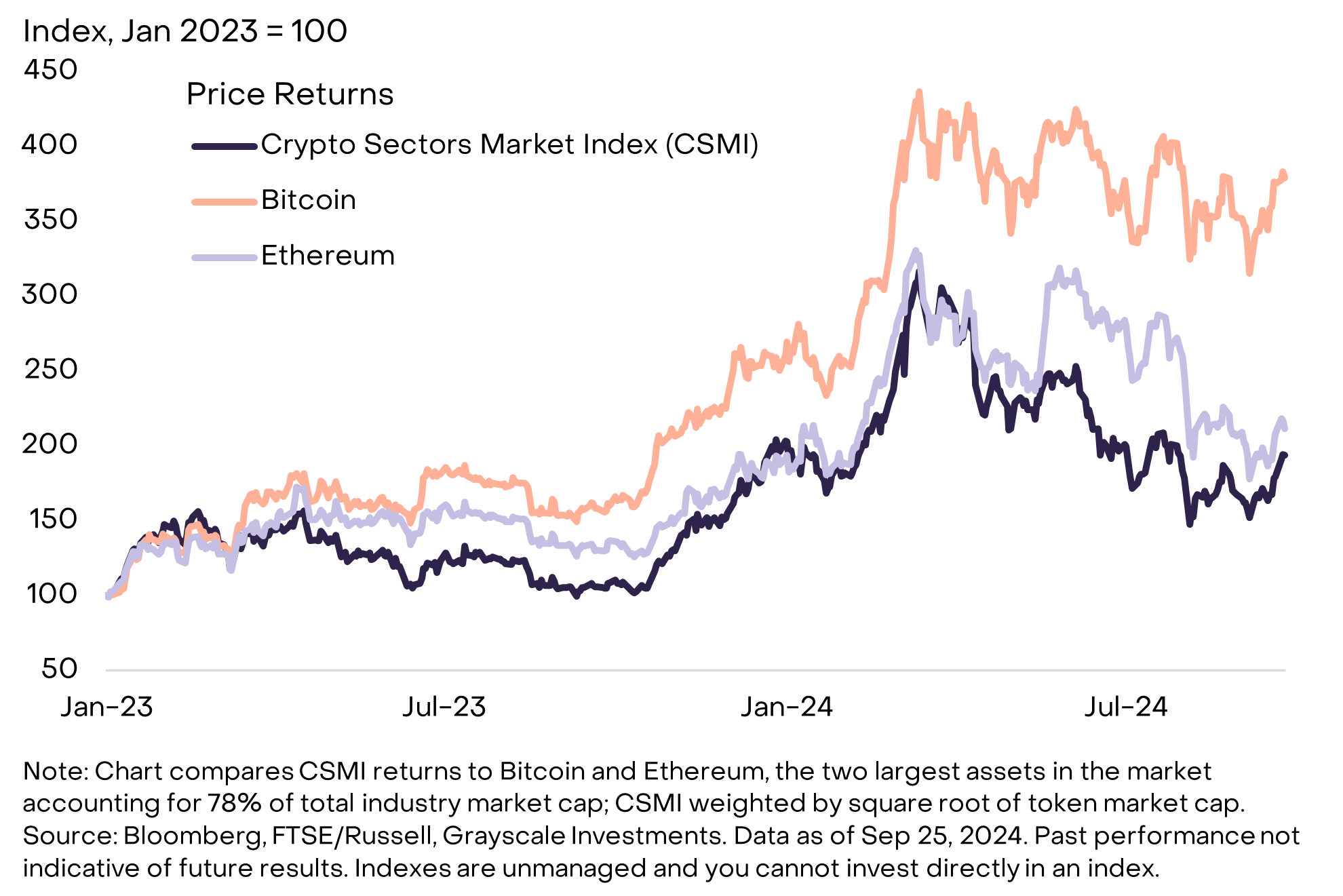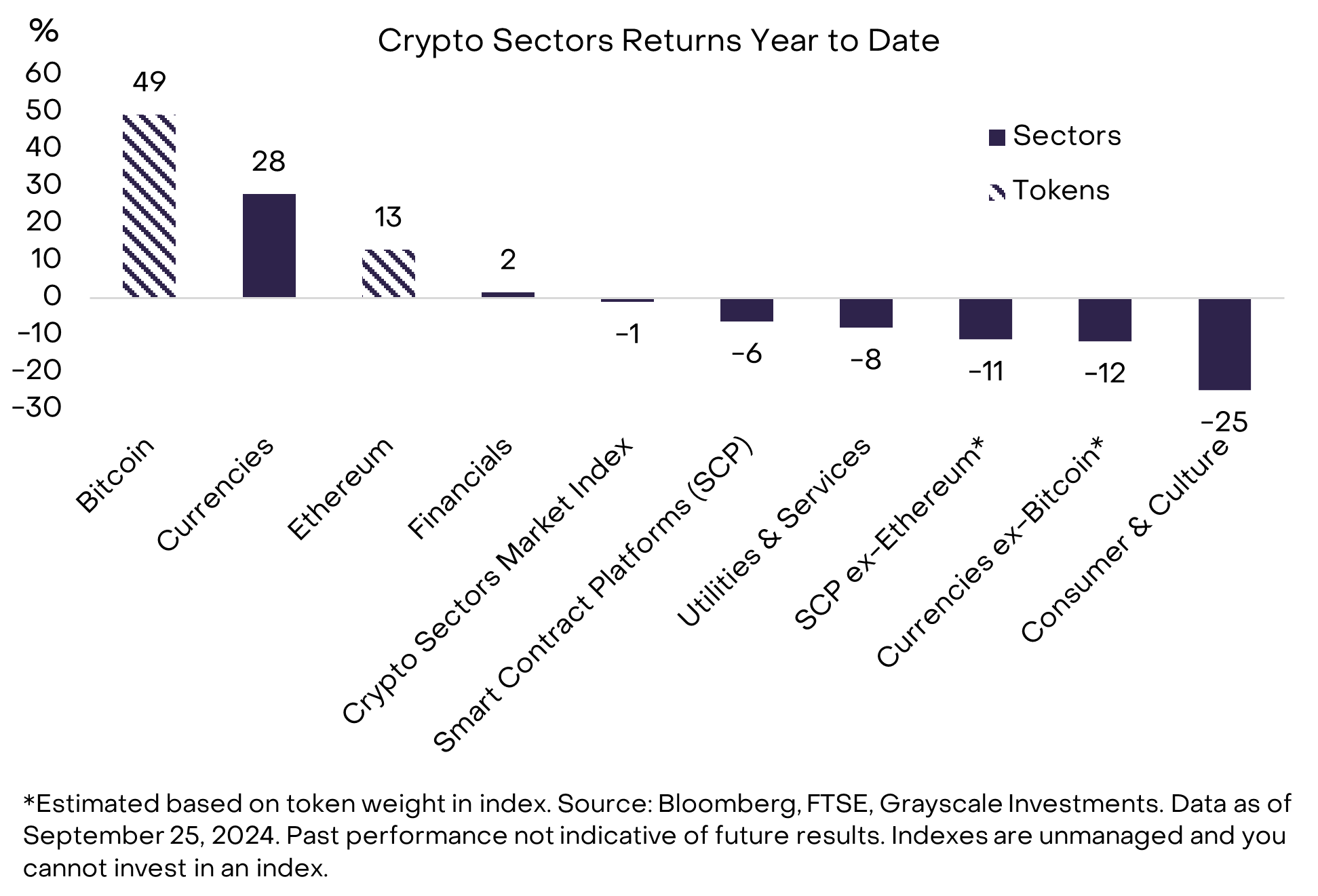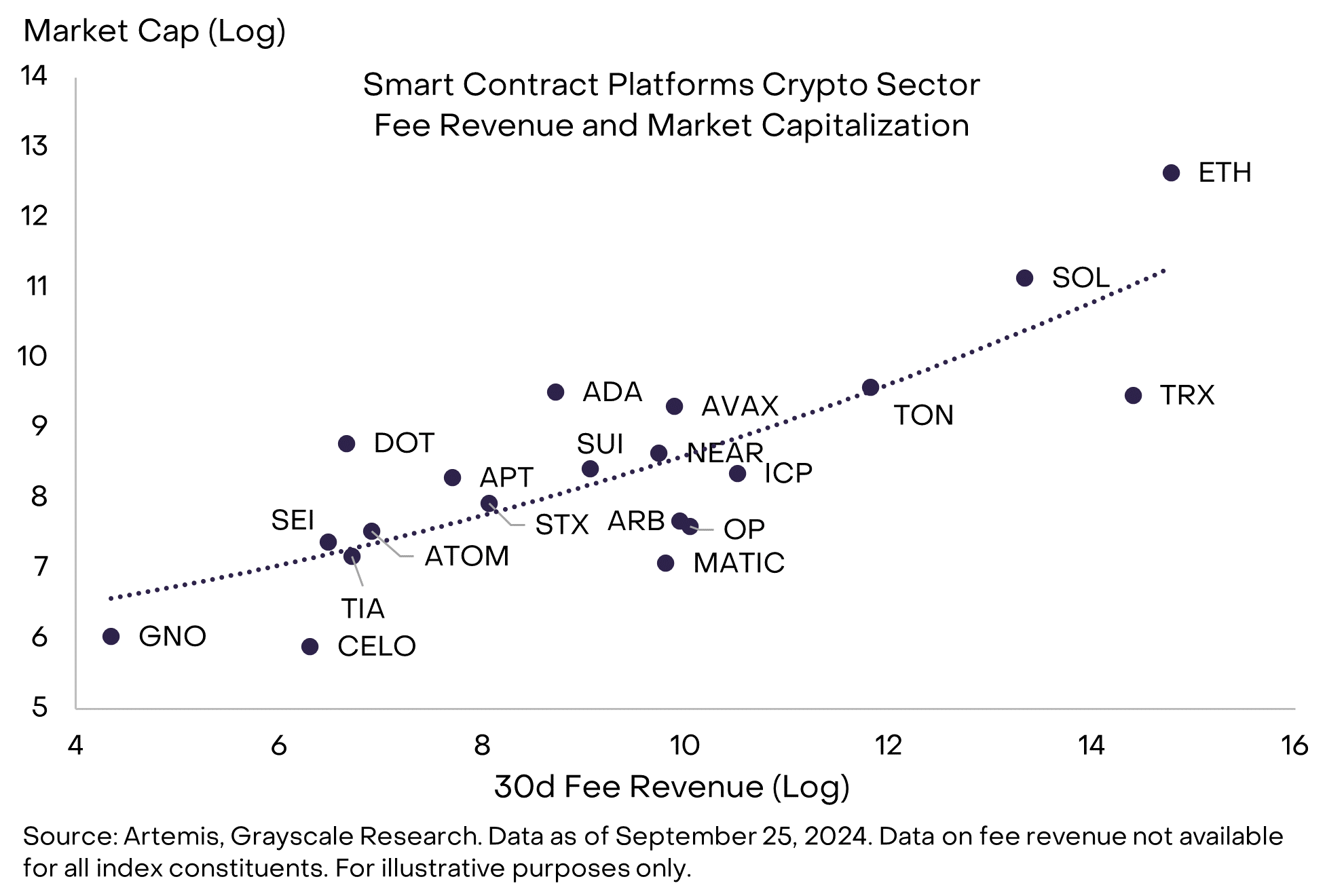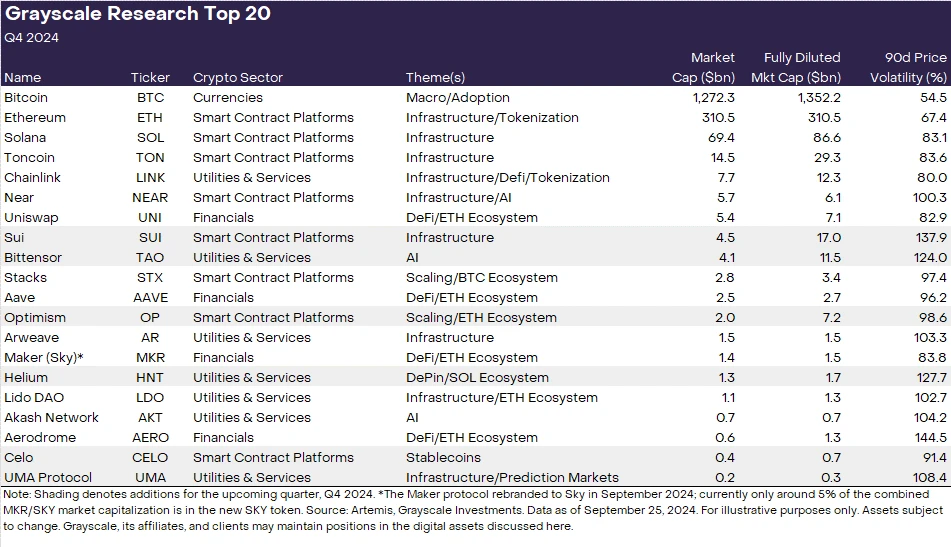Ausblick für die Grayscale-Kryptobranche im vierten Quartal: 6 potenzielle neue Vermögenswerte, die es wert sind, beachtet zu werden
Originalautor: Graustufenforschung
Originalübersetzung: Felix, PANews
Wichtige Punkte
-
Crypto markets are trading sideways in the third quarter of 2024, according to the FTSE/Grayscale Crypto Sector Index.
-
The changes to the FTSE/Grayscale index series highlight emerging themes in the digital asset industry, including the rise of decentralized AI platforms, efforts to tokenize traditional assets, and the popularity of memecoins.
-
Although Ethereum has underperformed Bitcoin so far this year, it has outperformed the Smart Contract Platform Index. Grayscale Research believes that despite fierce competition in the smart contract platform field, it still sees multiple reasons why Ethereum can maintain its position.
-
The top 20 tokens compiled by Grayscale Research have been updated. The top 20 represents a diversified portfolio of assets in the crypto industry. These assets have high potential in the coming quarter. New assets added this quarter are SUI, TAO, OP, HNT, CELO, and UMA.
-
The top 20 assets listed all have high price volatility and should be considered high risk; the US election may also be a major risk event for the crypto market.
Grayscale Crypto Sectors provides a comprehensive framework for understanding the range of investable digital assets and their relationship to the underlying technology. Based on this framework and in partnership with FTSE Russell, the FTSE/Grayscale Crypto Sectors Index Series was developed to measure and monitor the crypto asset class (Figure 1)
Figure 1: Crypto Industry Index measures asset class performance

The Crypto Framework is designed to be updated with evolving market dynamics and is adjusted at the end of each quarter. The latest adjustment process ended on September 20. Since the beginning of the year, the index adjustment process reflects new listings, changes in asset liquidity, and market performance. This years update to the Crypto Industry Index highlights emerging themes in the digital asset industry, including the rise of decentralized artificial intelligence platforms such as TAO, efforts to tokenize traditional assets such as ONDO, OM, and GFI, and the popularity of Memecoins such as PEPE, WIF, FLOKI, and BONK.
From a returns perspective, Bitcoin has already outperformed other market segments in 2024 (Table 2), likely reflecting the successful launch of spot Bitcoin exchange-traded products (ETPs) in the U.S. market and a favorable macro backdrop for the asset.
Chart 2: Bitcoin has performed well this year, but Ethereum is still doing well

Ethereum has lagged behind Bitcoin this year, up 13%, but has outperformed most other crypto assets. For example, the Crypto Sector Markt Index (CSMI, which measures returns across the entire asset class) is down about 1% this year. In fact, excluding Ethereum, the Smart Contract Platform Crypto Industry Index is down about 11%, so Ethereum has clearly outperformed its market segment. Across all assets within the crypto framework, Ethereum has returned about 70-75% year-to-date. So, while Ethereum has appreciated less than Bitcoin, it has still performed well this year compared to the crypto industry and the broader CSMI.
Focus on Smart Contract Platform
Unlike Bitcoin, which dominates the crypto space, Ethereum faces stiff competition in the smart contract platform space. This year, many alt smart contract platforms have gained traction, including Solana, Toncoin, Tron, and Near, as well as new platforms like Sui. These assets are all competing for fee revenue, and the “silky” user experience provided by some smart contract platforms may lead to a decline in Ethereum L1’s fee market share.
At the same time, Ethereum has various comparative advantages to support its dominance (Table 3). Most importantly, Ethereum remains the leader, with the most applications, the most developers, the highest 30-day fee income, and the most locked value. When including the largest Ethereum L2 network, Ethereum has the second-highest number of daily active users after Solana.
Chart 3: Ethereum is the leader in the smart contract platform fee revenue category

As public blockchain technology continues to be adopted, the entire smart contract platform is expected to grow in users, transactions, and fees. This is likely to benefit all assets in the category to some extent. Since Ethereum is the leader in the category, with its existing network effects, it will benefit from the continued growth of smart contract platforms. For this reason, even though Ethereum faces fierce competition, it remains an extremely attractive asset in the crypto space.
In addition, Ethereum benefits from certain specific features that may still temporarily lead its competitors. These features include high network reliability, high economic security, high decentralization, and clearer regulatory status in the United States. There are also encouraging adoption trends in the Ethereum ecosystem, including tokenization, prediction markets, and construction by large companies such as Sony. For all these reasons, Grayscale Research continues to believe that Ethereum is a very attractive investment theme.
Top 20 Assets
The top 20 assets compiled by Grayscale Research represent a diverse set of assets in the crypto industry that have high potential in the coming quarter (Table 4). The ranking methodology takes into account a range of factors, including network growth/adoption, upcoming catalysts, sustainability of fundamentals, token valuations, token supply inflation, and potential tail risks.
Six new assets will be added in the fourth quarter:
Sui: A high-performance L1 smart contract blockchain that delivers innovative applications.
Bittensor: A platform that facilitates the development of open and global AI systems.
Optimism: An Ethereum scaling project based on Optimistic Rollups.
Helium: A decentralized wireless network running on Solana and a leader in the Decentralized Physical Infrastructure (DePin) category.
Celo: A blockchain project built specifically for mobile devices that is transitioning to the Ethereum L2 network, focusing on stablecoins and payments.
UMA Protocol: An optimistic oracle network that serves the leading blockchain-based prediction market Polymarket (among other protocols).
Figure 4: High-potential assets in the crypto industry in the fourth quarter of 2024

The newly included blockchains reflect several crypto themes that Grayscale Research focuses on. Sui and Optimism can both be considered examples of high-performance infrastructure. Sui is a third-generation blockchain developed by a team of former Meta engineers. Two months ago, Sui had a network upgrade that increased transaction speeds by 80%, surpassing Solana, a network that has recently seen an increase in adoption. Optimism is an Ethereum L2 that is helping to scale the Ethereum network and has developed a framework for building scaling solutions, called “superchains.” Coinbase’s L2 network Base and Sam Altman’s Worldcoin built L2 are both using this framework.
Both Celo and UMA benefit from unique adoption trends: stablecoin usage and prediction markets. Celo is a blockchain focused on stablecoins and payments in the developing world, gaining traction in Africa, led by the MiniPay app for the Opera browser. Celo recently surpassed Tron as the blockchain with the largest number of daily stablecoin addresses. It is currently migrating from a standalone blockchain to Ethereum L2 in the Optimism hyperchain framework. UMA is the oracle network used by Polymarket, a breakthrough application in the crypto election year. UMA records the resolution of each Polymarket event contract outcome on-chain and facilitates voting on disputes over Polymarket outcomes, ensuring that the resolution is not interfered with by centralization, arbitrariness, or bias.
Helium is a leader in the DePIN (Decentralized Physical Infrastructure Network) category, leveraging a decentralized model to efficiently distribute wireless network coverage and connectivity resources and reward participants for maintaining network infrastructure. Helium has expanded to over 1 million hotspots and 100,000 mobile users, with over $2 million in network fee revenue so far this year.
While Bittensor has been focusing on the decentralized AI theme for some time, it has only now been incorporated into the crypto industry framework due to improvements in market structure (specifically more available pricing sources and higher liquidity). Bittensor has emerged as a dual crypto and AI player that aims to create a global decentralized platform for AI using economic incentives, thereby dominating the market.
Grayscale Research rotated the following projects out of the top 20 this quarter: Render, Mantle, ThorChain, Pendle, Illuviu, and Raydium.
Investing in crypto assets involves risks, some of which are unique to crypto assets, including smart contract vulnerabilities and regulatory uncertainty. In addition, all of the assets in the top 20 have high volatility and should be considered high risk and are not suitable for all investors. Finally, broader macroeconomic and financial market developments may affect the valuation of crypto assets, and the US election in November should be considered a significant risk event for the crypto markets. Trump has clearly welcomed the digital asset industry, and Vice President Harris recently stated that her administration will encourage innovative technologies such as artificial intelligence and digital assets while protecting consumers and investors. Given the risks of this asset class, any investment in digital assets should be considered in the context of a portfolio and with consideration of the investors financial goals.
This article is sourced from the internet: Grayscale Crypto Industry Q4 Outlook: 6 Potential New Assets Worth Paying Attention to
Related: Is a Solana Spot ETF Coming?
Original author: 0x Edwardyw introduction The US cryptocurrency exchange-traded fund (ETF) space has seen significant progress in the past year, with spot Bitcoin and Ethereum ETFs being approved. Despite these developments, even with a well-known asset management company recently submitting an application for a spot Solana ETF, the likelihood of approval by the US Securities and Exchange Commission (SEC) in the near future remains uncertain. This article explores the current status of the Solana ETF application, the regulatory environment, the political impact, and the impact it may have on the price of SOL if approved. Solana ETF Application Current Status In June 2024, VanEck and 21 Shares applied to the U.S. Securities and Exchange Commission (SEC) for approval to launch an ETF tied to Solana. These applications represent the first…







